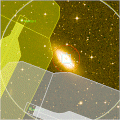
| You are in: Observing Tool (OT) > Special Instructions > Semester 2004A |
 |
Instructions for Completion of Phase II/OT Science Programs: Semester 2004A |
![]() This page provides
instructions for completing Phase II Science Programs for all Gemini
North and Gemini South instruments as well as the Phase
II deadlines. Failure to adhere to these deadlines may mean that your observations will not
be executed.
This page provides
instructions for completing Phase II Science Programs for all Gemini
North and Gemini South instruments as well as the Phase
II deadlines. Failure to adhere to these deadlines may mean that your observations will not
be executed.
All observations must be defined using the Observing Tool (OT) software. Gemini staff will translate approved Phase I proposals into the Phase II format for loading into the OT. In this process, the observations and other details entered in Phase I are used to construct a ("skeleton") framework of your Science Program.
As in the previous semester, the Phase II skeletons are downloaded/uploaded directly from/to the Gemini telescope databases to enable more efficient and rapid processing. See more information on using the Observing Database.
A new release of the OT ("wimbledon") was made available in mid-December to support Semester 2004A Phase II preparation (as well as on-going 2003B programs); do not use the previous "broadway" public release. If you are not already familiar with the OT, there is an OT tutorial that provides a useful introduction.
After receiving instructions on Phase II skeleton retrieval you must define the observation details using the OT tutorial as an initial guide. There is more extensive help regarding OT features on the OT web pages.
If during detailed definition you find that the approved observations need to be modified, please follow the change request procedure.
The National Gemini Offices are responsible for Phase II support for the "established" facility and visiting instruments as mandated by the Gemini Board. Phase II support for the other instruments remains with the Gemini Observatory staff. In outline, the Phase II process for the established instruments is as follows:
You can help us and speed this process by checking the program yourself (see the OT/Phase II checklist and instrument-specific checklists on the OT instrument component pages).
For the other instruments (Acquisition Camera) the Gemini Contact scientist is the first point of contact for programs PIs.
Joint Proposals have an identified Principal Contact who will be the single point of contact for Phase II preparation and other queries. If you wish to change the Principal Contact, as identified in your ITAC feedback, please e-mail the relevant Gemini Associate Director immediately (jrroy@gemini.edu for Gemini North, ppuxley@gemini.edu for Gemini South) with a copy to your National Gemini office.
To help us in the process of tracking user problems, questions and suggestions, and thereby improving the software and web pages, please use the Gemini HelpDesk for any queries. This allows us to ensure that no queries are missed and help us improve the software and documentation. A streamlined interface is available, keyed to your Gemini Program ID (e.g. GS-2004A-Q-12). As with the regular HelpDesk interface, your query will be directed to NGO or Gemini support staff as appropriate (the support staff are listed on the Phase II support web page)
The mechanism for submitting your completed Phase II Science Program is similar to skeleton retrieval (see the Observing Database information for more details) and is the same for all instruments (although submission of MOS mask definition files is handled separately, outside of the Observing Tool, via direct e-mail).
Completed Science Programs must be submitted by the following deadlines (all 6pm local time):
| Phase II deadlines for all instruments | |
| Deadline | Notes |
| 12 January | For any programs, especially those that can be executed early in the semester |
| 10 February | For all remaining programs |
| various | Deadlines for GMOS mask design (several, adjacent to instrument blocks) |
Note that only the observation descriptions received by these dates can be verified and made available for execution in the queue.
In some cases GMOS PIs may be contacted directly and asked to submit their Phase II early to provide sufficient observations for pre-imaging and MOS spectroscopy at the very start of the semester. All pre-imaging observation descriptions must be submitted by the regular deadlines (see table above). Note the separate deadlines for submission of MOS mask designs.
All PIs of classical programs must also submit Phase II Science Programs. The deadline for these is two weeks prior to the instrument block in which the classical nights are scheduled. (See the 2004A classical schedule and 2004A instrument schedule).
The 2004A queue summary page show the current execution status (click on the active link) of all queue programs and indicates when data have been taken.
Last update December 10, 2003; Phil Puxley